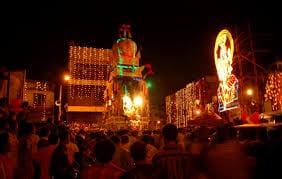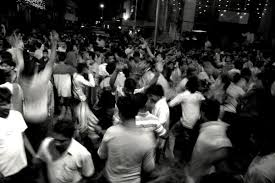I am a native of Bangalore city, a Kannadiga from an orthodox family, yet I found myself asking my non-Bangalorean friends, “What is the Karaga festival?” One of those moments when I feel I should have paid more attention during social science class! One friend, who closely follows cultural happenings around the city, told me more.

The 40 ft ratha carrying the idol of Lord Dharmarayaswamy in procession. Devotees gathered on the streets throw bananas and tulsi leaves on the ratha. (pic: Deepika Nagabushan)
Karaga is celebrated on the full moon day during the Chaitra month of the Hindu calendar. The Thigala community in Bangalore hosts this in praise of Goddess Shakti. The Dharmarayaswamy temple (because Shakti is an avatar of Draupadi, Dharmaraya’s wife) in Bangalore gets dressed up as it turns into the centre of action during the celebrations. A few highlights of the event: a procession of the 40 foot high ratha carrying the idol of Dharmaraya led by the Karaga carrier and tens of thousands of people gathered to witness it. The Karaga carrier visits several designated spots in the neighbourhood with a pot adorned with flowers on his head, a symbolic representation of Goddess Shakti.
Having witnessed the festival celebrations once earlier, another friend mumbled, “Don’t go, it’s not a place for women!”
Not a place for women? What’s that now? Of course, that sort of advice does not make the cut with me. Plus, when I heard about it, it sure did sound like an event I wanted to see and capture in photographs. So I charged my batteries, packed my camera and headed out at 10 PM on 7th April.
When I got there, a colourful play was in progress, part of the Mahabharata. I had apparently missed out on shooting a dramatic fire ritual, performed by the veerakumaras, an integral part of the procession; their role is to guard the Karaga carrier with ornamental swords. At first it did not seem too bad and I thought to myself, “Glad I did not stay home; I would have missed so much.” And the thought of being there delighted me. “I am the first female photographer to have documented this event, just because I dared to!” Little did I know there was a price to pay!

Devotees playing the role of Veerakumaras, waiting with their swords for the Karaga carrier to walk into a small temple that they are guarding. (pic: Deepika Nagabushan)
Capturing the play seemed very rewarding as I gained permission to go backstage to take photographs. I started to get the taste of the real festival when someone asked me to take their picture. I obliged at first. But the second, third and fourth photographs were sort of forced. Even after that I kept hearing claps with the words “hey… hey…” from behind me. Knowing that it was a call from the same drunk man asking for more photographs, hopeful that he would appear in a newspaper, I turned a deaf ear. When the claps started getting louder I asked for help from a fellow photographer. He entertained their last request and we made our exit from the scene.
It was about 11.30 PM now. We walked towards the Dharmarayaswamy temple. The roads seemed empty, with used plates strewn all over. I thought we had missed it all. But the chaotic street scene was a harbinger of more chaos. We walked on and the crowd got larger. The ratha was yet to come out. It was scheduled to come out only past midnight; we still had time. We found out about another ritual that the veerakumaras perform, near the temple before the ratha heads out. Having decided we wanted to shoot it, we finally dared into the packed street.
Claustrophobia was going to become the least of my concerns after I went past the no-turning-back point. We walked in a line; my fellow photographer in front, I behind him and my sister in between. I was alright until my sister suddenly turned around and screamed at a guy in the crowd. The reason is quite the no-brainer type. As if that was not enough to get me angry, it happened again and again. Not just with her, but with me as well.
I only want to ask one question.
How in the world, when you hardly have enough air to breathe, have no control over your movements, are getting pushed in a direction by the crowd that has come to celebrate a religious festival, you have the time to notice a girl in the crowd and then in that helpless position pull your hand out and reach her butt in order to give in to your animalistic instincts?
I ask how? Not why! Because if I ask why, I am sure to be treated with absolute silence. Or, with “I told you not to go!” Even worse, have a question thrown back at me “What were you wearing?”

Unruly crowd of only men, dancing into the wee hours to loud Kannada film songs, with hardly any police supervision. (pic: Deepika Nagabushan)
All I can do is laugh it off. There is no choice left, is there? However, at that point in time, I found myself cursing loudly and using my camera as a weapon to bash people’s heads. The police noticed this and blamed my poor friend for having invited women into the crowd!
Is it the only solution, to keep women from attending community events such as this one? “Just avoid, what will you miss if you don’t go?” But hey, the problem is much larger! It’s not about me having missed the event but about the fact that there exists a ‘place not for women’. Should something like that really exist? Should we turn a blind eye to the ever increasing list of general public places that go into this category every day?
The reason why I did end up going was a practical one. I cannot think of any violation of sorts that Indian women do not confront and conveniently brush aside, discounting men as hooligans. I guess I was sub-consciously prepared to confront and forget.
Is that it? We are supposed to live our lives; feeling violated, but forever forgiving the imbeciles.
Someone told me once that there are only two things that can stop men in India from behaving this way. One, either they get over exposed to women at an early age, bringing the frustration of having not expressed themselves sexually, down to negligible. Then they won’t go crazy when they see a woman in close proximity. Or two, their expression is suppressed by the rules of society so much that they dare not treat another human being, forget women, without respect.
Which way are we headed? I don’t think the answer to this question is easy.
No wonder, I consider it one heroic adventure, having gone and photographed all the way till 4 AM in the morning, at an event where women fear to tread! But I feel good also because, as a citizen of Bangalore, I got first hand experience of a festival that claims to be one of the oldest in the city. And at what price!
⊕
I was there, earlier in the evening (8.30pm), and I noticed a lot of lady constables fanning out. There were a lot of women too at that point too, with children. It was a mela atmosphere.
Yes, it is supposed to be a family atmosphere. Hopefully, they did not have to go through this.
I was told the same thing – “no place for women”. But I couldn’t go for other reasons. Like all the festivals that are over publicised, it also attracts all the unwanted kind.But such behaviour is certainly not pardonable.
And the paradox is the deities are Dharmaraya – the follower of Dharma and Draupadi – the feminist of those times.
Stunning writeup.
Hats of to u two brave girls.
Deepika, what happened was terrible and it’s sad women today are going through this silently. Adding to your reasoning of why men are like this, women being stereotyped in our movies as shallow and just eye candy who are impressed in one quick song sequence also contributes to this attitude. Being rowdy, desperate and unapologetic is glorified by our hero’s in movies .Think most people are following the trend. Would you agree?
Agree 100% Ravi. But, stopping this kind of representation in the movies will not be able to put a stop to this either. One small way is to probably keep bringing to light such behaviour and publicly ridicule any incident of this sort… hopefully it will take a few years until men truly look down upon such behaviour and restrain…
bringing such incidents to light will surely be a positive contribution to this issue, and that’s what your article does. But unfortunately until a big incident does not capture the nation’s attention, very less will be done. The safety of women is analogous to the ragging situation a few years back. It was an accepted thing, a cool thing to do in fact. Until the impact it had on the victims was brought forward by a few terrible incidents.
Dear Ms. Deepika,
I have read your article today 10.3.2012.You have misunderstood about the concept. Firstly, I as Veerakumara stating that we gave respect to Women and not only that we give first preference for ladies to view the Karaga in the temple premises and not for men which may kindly be noted. Probably you came to near temple off late, so that the things what you narrated is happened.
I request you kindly to visit Dharmaraya Swamy Temple on foregoing Karaga Festival during 6.4.2012.
Deepa Arathi on 3.4.2012 midnight.
Hasi Karaga on 4.4.2012 midnight.
Karaga on 6.4.2012.
For Karaga, kindly visit temple at 10 PM Night on 6.4.2012 so that you will find lot women gathering there.
Regards
J. Nanda Kumar
Thanks. However, just to clarify, we are not talking about the festival itself. Instead about any such mass public event where women cannot go without being subjected to the nuisance created by unruly men, who are not controlled by the arm of law or their own values! The Karaga is carried out by the veerakumara at midnight, right? And not at 10 pm. In that case why should a woman have to choose instead to attend the pooja at 10 pm inside the temple. Why is that choice not avbl for women to experience any chosen part of the festival. Why must women always be given one single customised option of being inside the temple at 10 pm and nothing else. Why must this artificial protection be given to reinforce the misleading idea that the onus is always on women to behave and be safe. The onus is supposed to be every man to behave like a man, why is that never expected from them.
One odd chap in the crowd may be a gentleman. The mob mentality is such that menfolk use such crowds to tease and grope women. Of late, no city, town or village is safe at any time for women. Our culture has gone to dogs. There is no guarantee that a policeman will help you. You may face a different animal there. The first thing he may ask you is why you are there !! The daily dose of rapes, murders and kidnappings show that women have no place in our present day society. It has come in the Papers recently that women are the cause for trouble because of their freedom !! I think our menfolk are not born to mothers and do not have sisters. Women’s pictures in seminude conditions are being used in the Press and movies for promoting products for men . Very sad state of affairs.